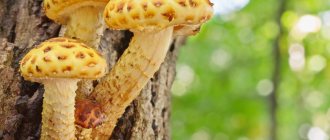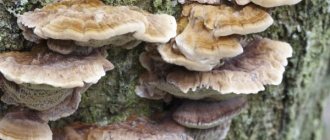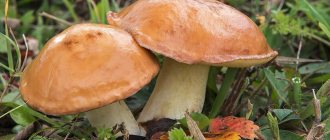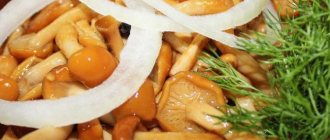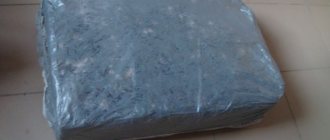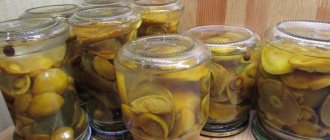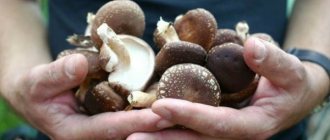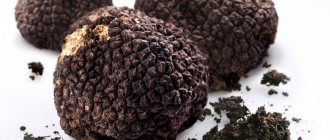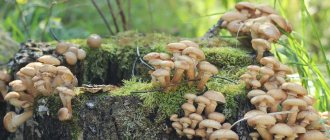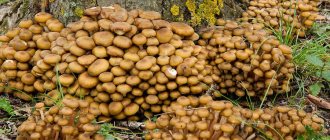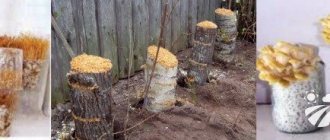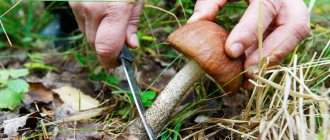Honey mushrooms is a word that unites a group of mushrooms from various families and genera. Why did these mushrooms get this name? In fact, everything is extremely simple, the word “honey agaric” has a common root with the word “stump”, and as you know, most honey mushrooms prefer to grow on wood (stumps, dead trees, weakened living and dry trees). The only exception here is meadow honey mushrooms; they grow on the ground, and received their name rather because of their external similarity with other representatives of this group.
- Hypholoma capnoides
As practice shows, when many people talk about honey mushrooms, they mean a specific type of mushroom, namely “autumn honey mushrooms (armillaria mellea),” since they are perhaps the most famous among amateur mushroom pickers. In fact, there are many other very tasty mushrooms included in the honey mushroom group, which are often avoided by people new to the mushroom kingdom.
Next, I propose to get acquainted with the main mushrooms related to honey mushrooms. You may well have seen some of them in parks or in the forest, and some of them may have even been seen in stores.
Description and features of the honey fungus
Honey mushrooms are one of the most famous agaric mushrooms. Mushroom pickers go in search of them at the end of the mushroom season (autumn). Small fruiting bodies with round caps are visible from afar, as they grow on natural hills - stumps and snags. Honey mushrooms gather in friendly groups; it is extremely rare to find a solitary fungus. As a rule, fungi parasitize trees, affecting about 200 species, as well as shrubs and even herbaceous plants.
The appearance of mushrooms is characteristic:
- The leg is thin with a special membranous ring in the middle.
- The hat is shaped like an umbrella, with scales.
- The color of the cap depends on the substrate on which the mushroom grows. Honey mushrooms growing on poplar, mulberry, and white acacia have a copper-yellow hue; on coniferous trees - reddish, on oaks - brown, on elderberries - dark gray.
- The plates under the cap are a pleasant yellowish-white or cream color.
Chemical composition of the mushroom
Honey mushrooms contain a high water content (up to 90% on average), which ensures their low calorie content. The remaining 10% comes from proteins (4%), fiber (2%), minerals (1.5%), carbohydrates (1.5%) and fats (1%). The nutritional value of the mushroom - per 100 g of product in grams - is as follows:
- dietary fiber – 5.1;
- proteins – 2.2;
- fats – 1.2;
- carbohydrates – 0.5;
- disaccharides and monosaccharides – 0.5;
- ash – 0.5.
The chemical composition of honey mushrooms includes essential amino acids and organic acids, antioxidants, and microelements. Among them:
- vitamins A, B, C, E;
- potassium – 400 mg per 100 g;
- iron;
- magnesium;
- calcium;
- phosphorus;
- sodium and others.
The nutritional value
A very small amount of honey mushrooms guarantees the body a daily dose of useful components.
Table - Representatives of energy value
| Element | gr |
| polyunsaturated fatty acids | 4,99 |
| mono- and disaccharides | 1,046 |
| water | 91,03 |
| alimentary fiber | 3,747 |
| saturated fatty acids | 1,312 |
| ash | 0,44 |
Honey mushrooms have a chemical composition that allows mushrooms to have a positive effect on hemoglobin levels. Frequent consumption of which will help cope with microbes, E. coli and staphylococcus.
A family of summer honey mushrooms on a stump
Mushrooms contain components that are very important for health. Therefore, you should not refuse dishes that contain them.
Benefits and harms of honey mushrooms
The rich composition of the mushroom and its balance determine the benefits of honey mushrooms. Fresh fruiting bodies are a source of vitamins and protein. The latter is a building material for the brain and muscles, and the concentration of this substance in honey mushrooms is equal to meat. Thanks to the action of amino acids, immunity increases and oxygen access improves. Unsaturated fatty acids are regulators of metabolic processes, they increase brain activity and restore damaged DNA.
Iron is responsible for creating hemoglobin and delivering nutrients to organs. Mushrooms that have undergone short heat treatment are useful for people suffering from anemia. Potassium and magnesium contribute to stable heart function. Ascorbic acid prevents tissue destruction; it fights toxins, improves the condition of the dermis, and relieves bleeding.
The anti-cancer substance flammulin was found in some types of honey mushrooms. Others contain antibacterial compounds. They slow down the development of harmful organisms, such as Staphylococcus aureus. Therefore, traditional medicine uses honey mushrooms as natural antibiotics. Beta-glucans in their composition are included in medications that prevent the development of cancer, hypertension, and diabetes.
In alternative medicine, warts are removed using an alcohol tincture of honey mushrooms, and mushrooms are also used as a natural laxative (especially in autumn).
Honey mushrooms are used in different forms, and each has its own advantages:
- Dried mushrooms are stored for a long time, they are higher in calories. They lose some of their beneficial properties. The same can be said about fried honey mushrooms.
- Pickled ones contain much less nutrients, but the mucus they contain has a positive effect on the stomach, and the fat-like organic substance lecithin prevents the formation of cholesterol.
- The best way to preserve the biochemical composition of honey mushrooms is to boil them and then freeze them. But freezing must be quick.
There are no contraindications to eating honey mushrooms as such. But some categories of people must comply with restrictions. These include:
- people suffering from diseases of the gastrointestinal tract;
- having renal failure;
- children under 5-7 years of age (due to the fact that mushrooms are a difficult product to digest);
- hypertensive patients.
You also need to be careful when picking mushrooms. Among honey mushrooms there are many varieties, as well as false representatives. An experienced mushroom picker can easily distinguish one from another, but beginners in “silent hunting” risk their health when they put a specimen in the basket that they doubt is edible. Compliance with basic safety rules during collection will protect you from unforeseen circumstances.
Harm to the body
Honey mushrooms cause harm to the areas where they grow. So the tree on which the family of mushrooms lived dries out over time. The harm to our body from consumption is as follows:
- Despite the low calorie content, honey mushrooms, like all other types of mushrooms, are difficult for the stomach;
- they should not be consumed in large quantities, especially for people with digestive problems;
- may cause diarrhea and diarrhea;
- if the mushrooms are undercooked, there may be poisoning.
Honey mushrooms can be both edible and “false”. They look almost identical. The only difference: the absence of a ring on the stem of false mushrooms.
Varieties of honey mushrooms
Both experienced mushroom pickers and those not the most savvy in this matter, unite under the general name honey fungus representatives of different genera (Armillaria - honey fungus and not only) and different fungal families: Tricholomaceae (ordinary), Physalacriaceae, Strophariaceae and others. 34 species are named, of which only 22 have been studied. There is no talk of systematicity, although outwardly all representatives of honey mushrooms are similar to each other. The name honey fungus comes from the Latin word “bracelet,” which indicates the special growth of mushrooms. But some honey mushrooms settle not as usual - on stumps, but in meadows, confusing mushroom pickers.
More is known about edible representatives of the honey mushroom genus than about inedible ones. The most common of them are combined into subspecies, united by time of growth and appearance:
- autumn or present;
- spring;
- summer;
- winter;
- thick-legged
- yellow-red and others.
Autumn honey fungus
The most recognizable representative of the honey mushroom genus. It has a convex cap that opens with age. Its diameter is 4-10 cm, rarely reaching 17 cm. The color of the skin varies, from honey-brown to dirty-swamp. Darkened in the center. The surface of the cap is covered with scales (they disappear during active growth). The mushroom stems are solid, up to 10 cm in length. The surface is light.
Young caps are dense, their flesh is whitish, but becomes thinner with age, and in the legs the insides are fibrous and become of a coarse consistency. The smell of edible autumn mushrooms is pleasant. The plates under the cap are sparse and grow to the stem. In young specimens they are beige, whitish, flesh-colored, and after maturation they darken a little, sometimes becoming covered with brown spots.
Autumn honey mushrooms germinate in damp forests - birch, aspen, elm, etc., on dead wood and stumps left after cutting down trees. They unite in groups, sometimes the fruiting bodies grow together with legs. The mushroom picking period is from August until the first frost (November-December). Honey mushrooms grow successfully at temperatures above +10, bearing fruit en masse in September (the first half of the month), when the thermometer shows 10-15 degrees.
Summer honey fungus
Sometimes this species is called Govorushka or Lipov. As a rule, this particular variety, which bears fruit from March to November, ends up in mushroom pickers’ baskets. The dimensions of Govorushka are more modest than those of the autumn honey fungus: on average, the cap is 6 cm in diameter and the leg is 7 cm in length. The cap is flat with a pronounced wide tubercle in the middle. Its color changes depending on the weather: when dry it is matte, honey-yellow, and when wet it is brownish and translucent. The edges of the cap are darker and have grooves. The skin is smooth.
The flesh of the mushroom is watery and thin, yellowish, and darker in the stem. Has the smell of fresh wood. The plates are frequent, up to 6 mm wide, brownish. On the stem the narrow ring is clearly visible. May be stained by fallen spores, which have an ocher-brown color. Below the ring are dark scales. Summer honey fungus grows in forests, uniting into large families. A favorite place is living trees with obvious damage, rotten stumps. It is found on deciduous trees, sometimes on spruce trees.
Winter honey fungus
A rare representative of mushrooms that can be found under the snow. This type of honey mushroom bears fruit in the colder months: from autumn to spring, appearing during thaws. Prefers dead deciduous trees - willow, poplar and others. It can appear in parks and gardens within the city, on the banks of a stream. Winter honey fungus usually grows in the northern temperate zone. Like others, it lives in groups.
The flat cap of the mushroom has a diameter of up to 10 cm, its color is orange or yellow, and its shape is flat. In young mushrooms, the shade is lighter at the edges and darker in the center. The leg is dense, tubular, with a characteristic velvety brown color. Yellowish-brown above. Length – up to 7 cm. No remnants of bedspreads. The plates are sparse, adherent, sometimes shortened.
Spring honey fungus
An edible fungus, also known as Collibia silica. It also grows on rotting wood or litter, choosing oak, pine and other species. Fruiting period of spring honey mushrooms: from May to October, the peak occurs in the summer months (June-July). The size of the fruiting bodies is small: the cap is from 1 to 7 cm in diameter, the stalk is up to 9 cm long, thin, flexible and expanding at the base.
The color of the cap is red-brown, prone to fading. Old mushrooms have folded edges. The shape changes with age: in young mushrooms it is convex, then broadly convex. The flesh of the mushroom is white or yellowish. The plates grow to the stem, their color is white, sometimes pinkish or yellowish. The color of the spore powder is white or cream. The spores are smooth, uncolored, drop-shaped.
Thick-legged honey fungus
A variety of honey mushrooms, belonging to the same genus and species as the real honey mushroom. It has a wide conical cap with a diameter of 3-10 cm with drooping edges. In young specimens, its color varies from pale brown to dark brown and pink, then becomes yellow-brown. The skin of the cap is covered with numerous grayish conical scales. Closer to the edge they almost lie.
The leg of the honey fungus is strong, cylindrical. It has a club-shaped thickening at the base. Young mushrooms have a “skirt”, but as they grow, it disappears, only the remains of a yellow cover are visible.
The thick-legged honey fungus has whitish flesh with an unpleasant odor and astringent taste, reminiscent of Camembert cheese. But the mushroom is considered edible. It is collected from August to November, finding groups of honey mushrooms in rotten leaves or on stumps. Favorite wood is spruce, beech, ash, fir.
Yellow-red honey fungus
It belongs to the family of Ryadovka, hence the alternative name: Yellow-red Ryadovka (or pine honey fungus). Grows in coniferous forests on dead wood (especially pine). Fruiting bodies are collected in groups. In central Russia, the period of mass fruiting begins from the second half of July until September. Meet until November.
A characteristic feature of the yellow-red row is the color of the cap. It is dry, velvety, covered with small purple scales. The color of the skin itself is orange-yellow. The diameter of the cap is 5-15 cm, the shape is flat (convex in young mushrooms). The plates and flesh of the mushroom are bright yellow in color. It is dense in the cap and fibrous in the stem, the taste is soft, slightly bitter, and the smell is sour, reminiscent of rotten wood.
Honey fungus mucous
This representative of the honey fungus genus is widespread in Europe and is found in deciduous forests. Favorite wood is beech, especially weakened trees. Also grows on maple, hornbeam; Honey fungus settles in groups, sprinkling the thick branches of living trees. The season for collecting these mushrooms is the entire summer season from May to September. Compared to other honey mushrooms, this species is little known.
The cap of the mucous honey fungus has a convex shape. As the name implies, they are mucous, hemispherical, white, cream or light gray, brownish in the middle. Diameter - up to 10 cm. The leg is thin, 2-8 cm long, often curved, cylindrical, and at the base it has a club-shaped thickening and a thick ring. Underneath it, brownish flakes form on the surface. Mucus appears on the stem below the “skirt”. The pulp is dense, yellow in color. The spore powder is pale cream.
Meadow honey fungus
The species of mushroom belongs to the genus Negniumaceae. Synonyms: non-rot mushroom, meadow mushroom, clove mushroom. Edible, but only the caps are edible, since the legs are too hard, especially in adult specimens. Honey mushrooms are small mushrooms, the diameter of the cap reaches 5 cm, the stem is on average 2-5 cm long. The weight of one fruiting body is on average 1 gram.
The cap of the meadow grass is flat with a blunt tubercle, reddish-brown or yellow. In the absence of moisture or in windy weather it takes on a light cream color. In addition, it has the ability to glow in the dark, like phosphorus.
The edges of the cap are almost transparent, torn, uneven. The plates are sparse, up to 6 mm wide, adherent in young mushrooms, and become loose with age. The stalk is thin and tortuous, solid, fibrous. Has the same color as the cap.
The main difference from other types of honey mushrooms is the place of growth. Lugoviki meet in open areas, gather in groups, forming “witch circles.” They prefer the soils of forest clearings, meadows, gardens, ravines, and roadsides. Meadow mushrooms are distributed throughout the world, from Europe to Africa. They are not afraid of severe drought; receiving moisture from rain, they come to life again. If the temperature is warm, this type of honey mushroom is collected from spring to autumn (May-June, September-October).
Why do honey mushrooms grow on stumps?
A group of honey mushrooms located on a stump.
Honey mushrooms grow on stumps because they use them as food. Appearing on wood, the fungus provokes its rotting and decay, while simultaneously absorbing nutrients. Honey mushrooms perform an important function in nature, since they accelerate the process of decomposition of forest objects and allow new ones to sprout in their place.
Interesting fact : if the honey fungus grows on the ground, it means that there are remains of a tree in the soil, which the mushroom feeds on.
Different types of honey mushrooms prefer to settle on certain trees. Thanks to this, most of the forest decomposes much faster when it becomes old and serves as fertilizer for the emergence of new plants.
Interesting: Poisonous mushrooms - list, photo, name, description, video, how to distinguish
Doubles again
Like many mushrooms, honey mushrooms have counterparts, including poisonous ones, from which you must be able to distinguish them in order to avoid poisoning. They grow in the same forests and at the same time (summer and autumn), they also gather in large colonies and settle preferably on dead wood and stumps.
Poisonous twins are found in all varieties of mushrooms, but in some countries certain twins are classified as edible mushrooms. If the collector is not sure, it is better to avoid “strangers”. But you need to know the enemy by sight.
The most famous types of false mushrooms:
- poppy;
- brick red;
- sulfur yellow.
Poppy honey fungus
Its other name is sulfur-plated. This is an autumn mushroom that grows from late summer to mid-autumn. The mushroom cap is convex, its lower part is covered with a blanket. With age, the cap straightens, its diameter reaches 8 cm. The color changes from pale yellow to rusty, brownish, reminiscent of poppy seeds. The edges of the skin are lighter. The surface of the cap is smooth, but becomes sticky in the rain. When the fruit grows in a humid environment, the skin turns light brown. The plates under the cap grow to the stem.
The honey fungus differs from a real mushroom by its long and thin stalk. It can be either curved or straight. Near the base the color of the leg is more red, and closer to the cap it is yellow. In addition, the sulfur-plated one does not have a characteristic feature of all honey mushrooms - a membranous ring. More precisely, it is there, but it quickly disappears. This can be confusing for an inexperienced mushroom picker. But this is not scary: the poppy mushroom is classified as conditionally edible. In appearance and taste it is similar to summer honey fungus.
Brick red honey fungus
This mushroom is considered conditionally edible or completely inedible due to its unpleasant taste. It is very bitter and requires long boiling. But information about its toxicity is contradictory, and in some countries, for example, in Japan and the USA, this representative of the genus is readily collected. Externally, it is distinguished by a larger cap; its diameter reaches 10 cm or more. With age, the shape of the cap changes from convex to flat. Its color is red-brown, but can be lighter or darker. Mushrooms have no smell.
Brick-red honey mushrooms grow in large groups on dead wood. They love deciduous and coniferous forests, but can be found in the mountains or plains. Grows all year round except during the cold winter months. Unlike real mushrooms, the inside of the cap of false honey mushrooms is covered with a cobwebby blanket. Over time it disappears, although remnants may hang from the edges. Another feature is that the mushroom stems are hollow inside.
Sulfur-yellow honey fungus
A poisonous twin of the honey fungus, having a pale yellow, sulfur-yellow or grayish color. The middle of the cap is darker than the edges. The plates below may have a greenish tint. The fungus is small in size, the diameter of the cap is from 2 to 7 cm, the stem is up to 10 cm in length. The shape of the cap of young mushrooms is similar to a bell, and when the mushroom grows, it becomes prostrate. The leg is fibrous. The flesh is whitish or the same color as the cap.
False honey fungus is found in deciduous forests, rarely in coniferous forests. Mushrooms grow in large groups, colonies can reach 50 fruiting bodies. Many of them are fused with legs. It is easy to distinguish the false honey fungus from a real mushroom by the sharp unpleasant odor that comes from the insides. In addition, the mushroom's double does not have characteristic scales, and its plates are sulfur-yellow in color, and not beige or cream, like edible mushrooms.
In order not to confuse honey mushrooms with their inedible counterpart, you need to pay attention to the growth characteristics of honey mushrooms:
- Real ones are found on wood (except meadow ones), and false ones can grow on the ground.
- The leathery ring on the stem is the main sign of edibility.
- In false species, the caps have a provocative color. They are greenish-gray, red, the plates are darker.
- The stem and cap of real honey mushrooms are covered with scales. False ones do not have them.
- As a rule, the legs of twins are thin and hollow inside.
- The doppelgängers give off an unpleasant, earthy odor.
Contraindications for use
Honey mushrooms of various types are grown on an industrial scale on wood waste or straw, considered a healthy food product, and in some countries a delicacy.
And yet, consumption is associated with risks for people suffering from inflammatory processes of the stomach and pancreas.
Contraindications for use are diseases of the liver and gallbladder, including its resection.
Improperly prepared, undercooked mushroom dishes without sufficient heat treatment can cause digestive upset and allergic reactions.
Mushroom products should not be included in the diet of children under three years of age, pregnant or lactating women.
How to collect honey mushrooms?
These mushrooms grow in large families; usually such an outing ends with the collection of an entire basket. In addition, honey mushrooms can be collected almost all year round - depending on the variety, they bear fruit from spring to late autumn, and even in winter (with the exception of severe frosts). Focusing on the collection time, you need to look for exactly those species that are common in these months:
- from May to June, meadow mushrooms actively bear fruit;
- from August to October-November - summer and autumn;
- winter ones occur throughout the fall, from September to December.
The forests in which honey mushrooms are found can be anything: mixed, coniferous, beech, etc. But, as a rule, they are not found in young thickets. Ideal for honey mushrooms is a damp forest that is 30 or more years old. Meadow honey mushrooms can also be found in plantings, but in open meadows and forest edges. A distinctive feature of these mushrooms is their constancy. If they appear near a rotten stump or fallen tree, they will subsequently appear there regularly. You can look for the family in the same place next year.
The best time to go for honey mushrooms is morning. After the cool of the night they are more resistant to transportation.
What can be prepared from honey mushrooms
Before preparing honey mushrooms, it is important to clean them properly.
- Separate the caps from the stems;
- Remove dirt and cut off damaged areas;
- Remove the headband, or “skirt” under the hat;
- Rinse the floor thoroughly with running water.
Fresh honey mushrooms are prepared in different ways. They can be boiled, fried, pickled. To store mushrooms for the winter, they are frozen or dried. Freezing preserves a large amount of useful substances; in winter they can easily be noticed as fresh. Dried honey mushrooms are used to prepare soups and main courses.
Fresh honey mushrooms reveal their taste very well when fried with onions, sour cream and potatoes.
How to grow honey mushrooms yourself?
Many mushroom lovers try to grow them themselves at home. Honey mushrooms are a unique mushroom crop that is more suitable for artificial cultivation than others. This process is accessible to everyone and it is exciting. Honey mushrooms will produce generous harvests almost all year round.
Honey mushrooms are unpretentious to grow. Winter and summer varieties are best suited for planting and propagation. The necessary conditions can be easily arranged in a summer cottage, vegetable garden, and even at home - on the balcony or in the basement.
The technology for growing honey mushrooms depends on the choice of seed. To plant honey mushrooms, you can use mycelium or the fruiting body, and the costs of both methods are minimal. To get mycelium, you can try to find a piece of rotten wood in the forest and grow mushrooms from it. The action diagram is as follows:
- Divide the rotten wood into equal pieces, the future grafting material. Their size is on average 2 by 2 cm.
- These bars are laid in finished wood, a kind of bed. Previously, holes are made in the sides of them, suitable in size to the pieces of grafting material.
- After the replanting is done, the bars are covered with moss, and then the entire bed is wrapped in polyethylene. This way, the required heat and humidity levels will be met.
To develop fruiting bodies from whole mushrooms, it is necessary to select worthy specimens for planting. To do this, the caps of old mushrooms (about 8 cm in diameter) are cut off, soaked in water, and a day later kneaded without straining. You should get a mass of mushy consistency. Next you need to proceed according to this scheme:
- Pass the pulp through two layers of gauze.
- Collect seed material in a glass container.
- Pour this liquid over wood (on logs or stumps).
- Garden beds or makeshift beds should have small depressions where spores collect.
- After planting, the holes are covered with sawdust or damp moss.
There are several ways to grow mushrooms at home or in your garden. The following are suitable for breeding honey mushrooms:
- in greenhouses;
- in the basement on bags;
- on logs;
- on a stump;
- in banks.
Growing on logs and stumps
This technology is suitable for breeding honey mushrooms both at home, subject to the required temperature (10-25 degrees), and outdoors. The log must be from a deciduous tree, fresh, not rotten, with bark and moist. If it is dry, you need to soak it in water for 2-3 days. Optimal log sizes: 30-50 cm in length, 20-50 cm in diameter. The prepared wood is planted in a tub, dug into a hole previously made in a suitable area, or left in a darkened room.
If a rotten stump is available (for example, from a tree cut down on the site), the mycelium can be planted in it.
How to plant mushrooms? In logs or stumps, it is necessary to make recess holes 4 cm long and about 1 cm wide. The distance is 10-15 cm from each other. Mycelium on wood sticks is placed in them, then the log is covered with film. It is necessary to make several holes in it to allow air to ventilate. If you maintain a temperature of about 20 degrees, the log will become overgrown with mycelium after 3-4 months. Moistened stumps can be kept in a greenhouse, where the humidity level can be easily controlled.
Growing honey mushrooms in the basement
If you plan to grow honey mushrooms in the basement, a comfortable temperature for mushrooms should be maintained there all year round. The mycelium is planted in bags with soil. You can use straw, leaves, seed husks, and sawdust for sowing. The plant components are pre-steamed in hot water for 10-12 hours. This is necessary to disinfect the soil from mold and pests. When the soil has cooled, the prepared mycelium is added to it and mixed.
The mixture must be placed in dense bags with a volume of 5 to 50 kg, made of polyethylene. The packages must be placed on racks in the basement or hung above the floor, and humidity and a comfortable temperature (14-16 degrees) must be ensured. After waiting three days, small holes are cut in the bags, their length is 5-6 cm. The first fruiting bodies will appear after two weeks. Honey mushrooms exhibit an amazing ability to reproduce under artificial conditions and produce high yields.
Growing in jars
This method does not require any site or extra space. Mushrooms are planted directly in jars, where soil or a substrate of sawdust and bran is placed (proportions - 3: 1). For a day, the mass is poured with boiling water (as sterilization), then with warm water, lightly squeezed and compacted. The mycelium is planted in a recess, which is made with a clean stick or pencil to the very bottom of the jar. After planting, the container is closed with a lid with holes and covered with wet gauze or cotton wool to maintain humidity.
The jars with seedlings are hidden in a dark, warm place, and the cotton wool is periodically sprayed. After 30 days, the mycelium will germinate, and after another 2 weeks (maximum 3), the first fruiting bodies will become visible. When the mushrooms sprout, the jar must be placed on the windowsill, darkened from the sun. Honey mushrooms should germinate up to the lid, then it is removed. The neck is wrapped in cardboard (a wide strip), which will support the grown mushrooms. The crop is cut, the stems are pulled out, and after the required 2 weeks, new fruits appear.
Growing honey mushrooms is not a troublesome task. Unlike other mushrooms, the first shoots appear much earlier. For example, you have to wait a whole year for the same porcini mushrooms and boletus mushrooms. In a small area (a liter jar or stump), a large family of mushrooms ripens. This is another pleasant bonus of breeding honey mushrooms at home. The tasty fruit bodies are subsequently used for pickling, drying, pickling and frying. And from all the variety of honey mushrooms, of which there are many types, you can choose any one you wish.
0
0
Copy link
Use in folk medicine
- To get rid of warts: cut off the mushroom cap and apply it to the affected skin. Apply a bandage on top and leave for 1 hour. Follow this procedure for two weeks. If the treatment does not help, make lotions from thistle juice. Sea buckthorn berries have a stronger antiseptic effect. They can be used to treat any inflammation or wound on the skin.
- For coronary artery disease, as well as to prevent the development of angina or arrhythmia: take the caps of the fruits and fill them with alcohol in a ratio of 1:5. Leave the product in a dark place for at least 7 days, then take 1 tsp. three times a day before meals.
- To prevent vein thrombosis and blood thinning, it is recommended to use this infusion daily: 1 tbsp. l. dried honey mushrooms are ground into powder and brewed with 200 ml of boiling water. Infuse the product for 2 hours, after which the cake is squeezed out and the liquid is filtered through a sieve. The resulting medicine is drunk 50 ml before main meals, but no more than 4 times a day. The course of such treatment should be at least 3 weeks. For anemia and other blood diseases, a decoction of reindeer moss is used as a multivitamin.
Eating methods
In nature, there are 2 main methods of nutrition - heterotrophic and autotrophic. What is their difference? All animals, many bacteria and fungi are heterotrophs. These organisms are not capable of synthesizing organic substances from inorganic ones. They must receive the necessary connections from the external environment.
Autotrophs are plants and some bacteria. Their cells contain special green plastids - chloroplasts. They contain a green substance - chlorophyll. It catalyzes a reaction after which carbon dioxide, nitrogen and water, under the influence of light energy, are able to transform into complex organic compounds.
Thus, plants provide themselves with the building and energy materials from which they grow. From the external environment they receive only water, oxygen and minerals.
Fungi are called heterotrophs; they are not capable of independently synthesizing organic substances from inorganic ones. In this they are similar to animals. The second point that brings this kingdom closer to fauna is the ability to secrete enzymes to break down complex compounds. Only in animals this process takes place inside the body, and in fungi - in the external environment.
These organisms also have something in common with the plant kingdom. They are brought together by the way they absorb nutrients. It passes by absorption from the substrate through the cell wall. In the highest representatives of the kingdom, this occurs through a special organ - the mycelium. But they do not have chlorophyll, which means photosynthesis is impossible.
What forests do they grow in?
It is important to understand in which forests edible autumn honey mushrooms grow. These fungi are parasites. They grow on dead wood. They are almost never found on healthy trees.
Thus, the most fungal forests are old deciduous, coniferous and mixed forests.
Honey mushrooms are extremely common in nature. The more dead trees in the forest, the more active myceliums, since honey mushrooms grow on old stumps. Clearings are the best places to look for autumn mushrooms in the forest.
They often appear on logs of the following types of trees:
- birch;
- alder;
- aspen;
- elm.
On these trees, the growth of edible autumn honey mushrooms begins within 2-3 years. At the same time, a fallen oak or pine tree can become the basis for a fungus only after 8-10 years. You need to regularly go to new clearings to find out in advance where this mushroom appeared.
Important! Autumn honey mushrooms love to grow in lowlands, because... Humidity is high in these areas. Mushrooms grow better in loose soils saturated with oxygen.
They rarely appear on living but severely damaged trees. In addition, you can look for these mushrooms near young and weakened birch, pine and oak trees. Fungi can often cause the death of these trees.
"Royal honey fungus" (hairy scale)
This example of the mushroom kingdom also has nothing to do with honey mushrooms. Nevertheless, among the people the nickname “royal honey fungus” has stuck to it, so I will still mention it.
It was called “royal” primarily for its appearance - the mushroom looks very impressive and photogenic, has a beautiful bell-shaped cap and is completely covered with large scales, the pattern of which vaguely resembles a royal robe.
As for the taste, the opinions of mushroom pickers are divided. Some consider this mushroom to be tasteless, while others, on the contrary, praise it and value it higher than the usual autumn mushroom. The fleecy scale has a distinct “rare” taste and smell.
“Royal honey fungus” grows in any forest - on stumps and trunks of old trees on rotting wood. Fruits from mid-August to late autumn .
Summer honey fungus
This mushroom, despite its considerable similarity, has nothing to do with real honey mushrooms. This is a representative of fungi with the unpronounceable name “Kyneromyces”. However, it is quite edible and is collected just as actively.
It grows on damaged living trees, but prefers rotten wood, and not just any wood, but deciduous wood (although sometimes this fungus is also observed on coniferous trees).
Photo 12. The lower surface of the cap of the summer honey fungus. Author: Björn S…
Summer honey fungus bears fruit virtually throughout the warm season - from April to November (and in countries with a mild climate - all year round).
The size of the fruiting bodies of the summer honey fungus is slightly different than that of the autumn one - the cap does not grow more than 6 cm in diameter, the leg is also three centimeters shorter. The color is somewhat lighter, more yellowish. The main difference is a wide tubercle on the cap, very noticeable - usually light, but sometimes dark. In addition, the caps of summer honey mushrooms are often smooth, and if they have scales, they are light.
This mushroom has a poisonous “double” (which will be discussed below in the chapter on the distinctive features of edible mushrooms from false and poisonous ones), so only experienced mushroom pickers collect it.
Favorable weather conditions for growth
Lack of precipitation, drought and high temperatures (over 25 degrees Celsius) have a detrimental effect on the mushroom mycelium - the fruits may not begin to grow at all, or they quickly die, losing moisture and collapsing from the inside.
Another unfavorable factor is sudden temperature changes (cold at night, scorching hot during the day). If fluctuations exceed the range of 10 degrees per day, the growth of honey mushrooms practically stops.
Excessive precipitation with frosts also does not contribute to a good harvest. If there is a heavy downpour once or twice in a few days, it’s time to run and check the “prey”. Has it been raining for weeks? Honey mushrooms will grow, but most likely they will be wormy and watery. In addition, mycelium requires oxygen, which does not penetrate well into the soil during droughts or floods.
From all that has been said, a simple conclusion can be drawn. The optimal air temperature for good growth of honey mushroom is 10-23 degrees Celsius. Humidity is high. Honey mushrooms grow in waves, so you can harvest them after every “serious” rain.
As a rule, from 1 to 4 streams of fruiting can occur during a season. It is important not to miss the moment and go check the forest a day or two after heavy rain.
Growing at home
Honey mushrooms can be grown in an artificial environment; you just need to recreate conditions favorable for this. You need to choose a place where there is shade most of the time of the day. The stump of a deciduous plant sits there; birch, pear or apple trees are best suited. After preliminary wetting the surface of the trunk, pieces of honey mushrooms are planted in its cracks and covered with moss. Next year, when the season comes, the stump will be covered with fast-growing mushrooms.
Interesting fact : a correctly planted piece of honey mushroom can produce a harvest for six years.
Growing honey mushrooms in a jar
If a person does not have his own garden, he can grow honey mushrooms in jars. To do this, you need to fill them by a third with bran, and fill the rest with sawdust from trees. Sprinkle flour and starch on top. The resulting mixture is poured with water and boiled thoroughly. The boiling process continues until most of the liquid has turned to steam, then the jars are cooled. When the temperature of the contents approaches room temperature, pieces of mushrooms are planted at the top, and then the necks are covered with lids with holes made to allow air circulation. In about a month, the tops of young honey mushrooms will appear on the surface. After this, the lid must be removed so as not to interfere with the growth of mushrooms.
